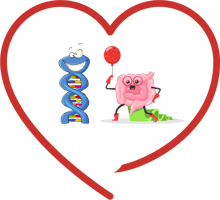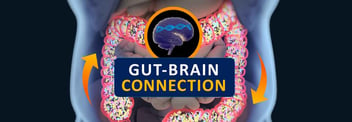Your Mighty Moody Microbiome – Part 1
- Home
- Blog

Your Microbiome – An “Invasion of the Body Snatchers”?
My Dear Reader, are you a spiritual person? Do you ever have spiritual experiences when you feel a sense of wonder and awe while walking out in nature, or when contemplating the exquisite complexity of each living being? I know I do. For example, I feel awestruck that each cell in our body contains 70 trillion atoms comprising 2 trillion molecules, whose complex interrelationships are “composed and conducted” by our DNA, creating a grand symphony within each living cell. And then add in an additional layer of symphonic complexity: each of the 32 trillion cells in our body interrelates with one another to create an even greater majestic symphony—that of a living human being!
Today I will introduce you to an equally extraordinary marvel and layer of complexity within your body: your microbiome, comprised of the 90 trillion microorganisms, each of which are intimately related to the functioning of your 32 trillion cells. In our new series, “Your Mighty Moody Microbiome,” you will learn how the DNA in these microorganisms is an extremely important “manufacturing plant” that also helps regulate the DNA in your body’s cells, and how you can use that information to improve your emotional health. As we journey together, perhaps you too will experience a sense of wonder and awe, and something spiritual alongside me. Let’s get started…
One of the best parts of returning from a summer vacation is undoubtedly sharing all of the wonderful memories with friends and loved ones upon your return. I adore hearing of others’ travels far and wide, across our abundant, beautiful earth. Like me, many of my friends are avid nature lovers, whose vacation pursuits usually crystallize around the idea of getting out of town and deep into the wild for as long of a stint as time will allow. There are many reasons to connect with the great outdoors, but for me, there is one element I particularly enjoy: I simply love sitting back after a long day spent fishing or walking and letting my eye adjust to the subtle workings of the natural world that surrounds me. Suddenly, I can see not just the trees but the birds inhabiting them, making their home there and in return spreading tree seedlings or berries far and wide, ensuring survival. I can see not just the flowers, but the bees nesting within, harvesting their pollen. A friend of mine recently came back from a scuba diving trip in Bali, and he told me similar stories: underwater, he spotted bigger fish getting “cleaned” by smaller fish, sea anemones attached to hermit crabs, feeding on their leftovers, and in return, protecting the crabs from octopuses and other dangers with their spikes. Reflecting on the wonderful interconnectedness of nature is a good reminder that we exist in a context much larger than our own… in fact, larger than we ever could’ve imagined.
It was the English poet John Donne who first wrote the words: “No man is an island.” While we can understand this conceptually, our American culture remains deeply imbedded in the idea of rugged individualism—that we don’t need anyone or any thing to make us happy. These messages often focus on people and things, rather than other creatures of the natural world, like the sea anemone depends on the crab. However much we may think of humanity as separate and above the laws of nature, we remain very much within the very same ecosystem as our animal relatives. And, as we are only beginning to understand, we don’t need to look very far outside of ourselves at all to appreciate our connections to other species. In fact, we need only look within. Inside each and every one of our bodies resides an entire universe of microscopic organisms; so numerous are these inhabitants that they outnumber our own cell count 3 to 1. In prior blogs, we discussed the microbiome. This blog marks the beginning of a series that widens the lens. For the next few weeks, we will be talking about the holobiont—the entire study of microbes living in our bodies, from the gut to the mouth and beyond. We will also integrate some of this knowledge with some of the genetic variants assayed by Genomind’s Mindful DNA test. Reader: this is truly the frontier of scientific research. In the coming decades, we may be able to treat any number of mental and physical health ailments using the holobiont exclusively. I am thrilled to dig into this exciting new topic. However, every journey must start with a single step—so let’s get to know the holobiont, what it is, and what it does!
The Holo-what? The Holobiont, Defined
Like many scientific terms, the holobiont cannot be fully understood without first having a solid underpinning of the context in which it arose—and the primary context we must get to know in this case is the natural workings of symbiosis. First coined in 1879, symbiosis is defined simply as two separate organisms (“symbionts”) living in close association with one another, and typically engaging in a mutually beneficial relationship (known as mutualism). The examples of inter-species interactions I described earlier are all examples of symbiosis. The tree could just drop its seeds on its own, sure. But the help of small birds greatly enhance the potential for that seed to spread—and the bird gets fed in the process. Of course, not all symbiotic relationships are mutual. Sometimes, just one species benefits, with the other remaining unimpacted (this is known as commensalism). Other times, one species benefits, while the other is actively harmed (parasitism—think of roundworms in animals).
Humans, too, engage in symbiosis every single second of every single day—from birth until death—without even seeing the symbiotic processes take place. The countless symbiotic interactions happening between our bodies and the microscopic organisms living within it is known collectively as the holobiont. The term was officially introduced in 1991 to define the interactions involving a single host and a single symbiont, but was extended to define a host and all of its associated communities of microorganisms. What, exactly, is the extent of these interactions? The answer may blow you away. Our human genome consists of about 20,000 genes. Our hologenome—or the sum of our genome and all associated microbial genomes—contains 33 million genes from our microbiota alone.
As this fascinating scientific paper on the topic states, “It is becoming increasingly clear that the development, growth, and health of macroorganisms (like us humans) are influenced by the complex microbial communities they host that shape their ecology and evolution. Biology is indeed undergoing a paradigm shift, where individual phenotypes (our physical characteristics) are seen as a result of complex interactions resulting from the combined expression of the host and associated microbial genomes.”
No man is an island, said John Donne… but who would have thought centuries ago that no man is biologically autonomous? Our bodies look so individualized from the outside—but the truth is, we have more foreign cells in our bodies than we have cells we can call our own. And these foreign cells contain 1650 times as many genes. We are a walking host for trillions of other organisms!
The Holo-Why? Why Should I Care about the Bacteria Living in Me?
History often looks back at the past and cringes at the mistaken ideas that have since been corrected. One of the greatest cringhes waiting for the next generations pertains to our ideas regarding the bacteria living within us. For decades, we believed all bacteria was bad bacteria. We tried to kill off these little microbes with antibiotics and worse. Only now are we beginning to see what an incredible ally this inner-universe could be to us—and that includes our present and future mental health outcomes.
In addition to the microbiome community living in our gut, we all have microbiome communities on our skin, in our mouth, in our urethra and bladder, and even in our lungs. And women also have microbiota in their vaginas. Most often, these bacterial communities engage with us in a mutually beneficial relationship—they help us feel good, and we feed them. However, if we have an unhealthy microbiome, we can encounter a state of dysbiosis. For example, if our gut microbiome is unhealthy, we may encounter allergies, hormonal changes, and have trouble losing weight. Each of these affects our mental health, both directly and indirectly—in fact, our mental health and our microbial health are engaged in a symbiotic relationship themselves. Our body can affect our mind via symptoms previously mentioned, and our mind can affect our microbial health just the same: diet, exercise levels, and hygiene, for instance all may shift depending on the state of our mental health—and each of these factors can play a role in keeping our microbiomes healthy or throwing them into dysbiosis.
Your Microbiome: Body Snatcher or Health Promoter?
Whether between our bodies and the microbes living within, or our microbes and our mental health, when symbiotic relationships fail or become more difficult, entire ecosystems are thrown out of equilibrium—including the individual ecosystems that comprise the emotional and physical you and me. Dysbiosis will “snatch away” the health of our 32 trillion cells! As we’ve previously seen in our discussions of the biopsychosocial model, our biology, psychology, and environment all play a role in our mental health, and coming to understand all of the ways our genes interact with our microbiome, to create profound effects on our emotional and physical wellbeing, will be an absolutely crucial element of treatment in the future.
Reader, I’ll put it plainly: if you want to have a clearer picture of your mental health and wellbeing, you should care about your holobiont. It will lead you to exciting new places, many of which we will explore in our upcoming blogs. Follow along—and give yourself a head start on creating a healthier future for you and those you care about.

.png?width=144&height=144&name=Untitled%20design%20(34).png)



